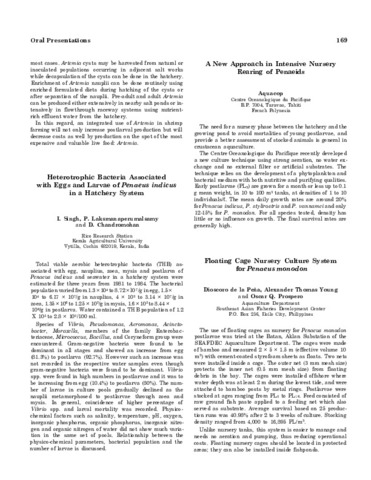Heterotrophic bacteria associated with eggs and larvae of Penaeus indicus in a hatchery system
Share
Abstract
Total viable aerobic heterotrophic bacteria (THB) associated with egg, nauplius, zoea, mysis and postlarva of Penaeus indicus and seawater in a hatchery system were estimated for three years from 1981 to 1984. The bacterial population varied from 1.3 × 104 to 8.72 × l07/g in egg, 1.5 × 104 to 6.17 × 107/g in nauplius, 4 × 103 to 3.14 × 107/g in zoea, 1.35 × 106 to 1.25 × 108/g in mysis, 1.6 × 105 to 8.44 × 106/g in postlarva. Water contained a THB population of 1.2 X 105 to 2.8 × 108/100 ml.
Species of Vibrio, Pseudomonas, Aeromonas, Acineto-bacter, Moraxella, members of the family Enterobac-teriaceae, Micrococcus, Bacillus, and Coryneform group were encountered. Gram-negative bacteria were found to be dominant in all stages and showed an increase from egg (81.3%) to postlarva (92.7%). However such an increase was not recorded in the respective water samples even though gram-negative bacteria were found to be dominant. Vibrio spp. were found in high numbers in postlarvae and it was to be increasing from egg (10.4%) to postlarva (80%). The number of larvae in culture pools gradually declined as the nauplii metamorphosed to postlarvae through zoea and mysis. In general, coincidence of higher percentage of Vibrio spp. and larval mortality was recorded. Physico-chemical factors such as salinity, temperature, pH, oxygen, inorganic phosphorus, organic phosphorus, inorganic nitrogen and organic nitrogen of water did not show much variation in the same set of pools. Relationship between the physico-chemical parameters, bacterial population and the number of larvae is discussed.
Paglalarawan
Abstract only.
Suggested Citation
Singh, I., Laksmanaperumalsamy, P., & Chandromohan, D. (1985). Heterotrophic bacteria associated with eggs and larvae of Penaeus indicus in a hatchery system (Abstract only). In Taki Y., Primavera J.H. and Llobrera J.A. (Eds.). Proceedings of the First International Conference on the Culture of Penaeid Prawns/Shrimps, 4-7 December 1984, Iloilo City, Philippines (p. 169). Iloilo City, Philippines: Aquaculture Department, Southeast Asian Fisheries Development Center.

